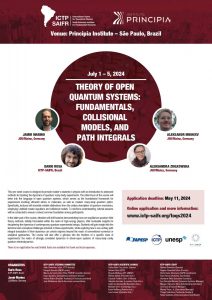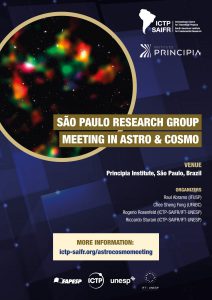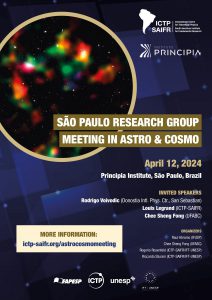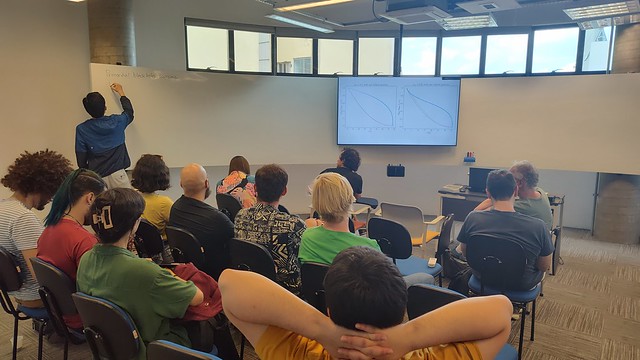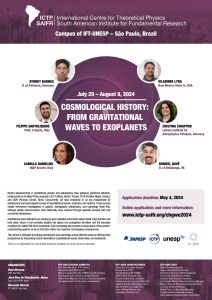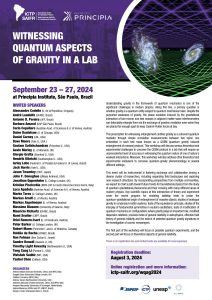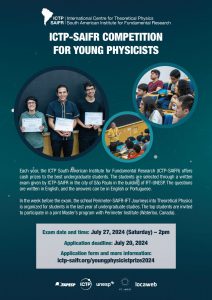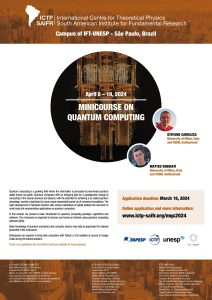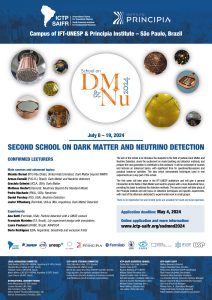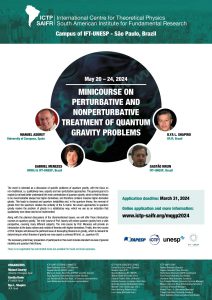Search Results
Minicourse on open quantum systems: fundamentals, collisional models, and path integrals
July 1 – 5, 2024
São Paulo, Brazil
Venue: Principia Institute
Home
This one-week course is designed to provide master’s students in physics with an introduction to advanced methods for tackling the dynamics of quantum many-body experiments.
The initial focus of the course will delve into the language of open quantum systems, which serves as the foundational framework for experiments involving ultracold atoms or molecules, as well as modern many-body quantum optics. Specifically, lectures will elucidate notable distinctions from the unitary description of quantum mechanics, employing Lindblad master equations and collisional models. To reinforce understanding, tutorial sessions will be conducted to ensure a robust common foundation among participants.
In the latter part of the course, attention will shift towards demonstrating how non-equilibrium quantum field theory methods, initially formulated within the realm of high-energy physics, offer invaluable insights for deciphering the dynamics of contemporary quantum experimental setups. Students will gain insight into the technical and conceptual challenges inherent in these experiments, while exploring how a non-unitary path integral description of their dynamics can unlock regimes beyond the reach of conventional numerical or analytical approaches.
The course will also offer a glimpse into the frontiers of a specific class of experiments: the realm of strongly correlated dynamics in driven-open systems of many-body cavity quantum electrodynamics.
Pre-requisites: A postgraduate course on quantum mechanics.
There is no registration fee and limited funds are available for travel and local expenses.
Organizer:
- Dario Rosa (ICTP-SAIFR, Brazil)
- Jamir Marino (JGU/Mainz, Germany)
List of participants: Updated on July 09, 2024.
Survey: HERE
Lectures
Students should be familiar with:
Negele, Orland ‘Quantum many particle systems’ chapters 2.2, 5.1 and 5.2 and ‘density matrix in quantum mechanics’ (Sakurai, ch. 3.4)
- Jamir Marino (JGU/Mainz, Germany): Lindblad equation and Keldysh formalism
- Aleksandr Mikheev (JGU/Mainz, Germany): 2PI and the Dicke model
- Dario Rosa (ICTP-SAIFR, Brazil): Collisional models
- Aleksandra Ziolkowska (JGU/Mainz Germany): Introduction to 2PI
Registration
Program
Students should be familiar with:
Negele, Orland ‘Quantum many particle systems’ chapters 2.2, 5.1 and 5.2 and ‘density matrix in quantum mechanics’ (Sakurai, ch. 3.4)
Poster session
- Pedro Barreto Melo (PUC-Rio): Stochastic Thermodynamics of Fisher Information
- José Lukas Montenegro Ferreira (Universidade Federal da Paraíba): Shortcuts to adiabaticity designed via time-rescaling follow the same transitionless route
- Luis Eduardo Herrera (University of Delaware ): Cavity-mediated enhancement of the energy transfer in the reduced Fenna–Matthews–Olson complex
- Guilherme Rafael Ferreira dos Santos (Universidade do Estado do Rio de Janeiro (UERJ)): Semiclassical dynamics of electrons in open topological systems
- Mariana Teixeira Santos (Centro Brasileiro de Pesquisas Físicas (CBPF)): Master equations for generalized subsystems
- Matheus Monteiro Ramalho Poltronieri Martins (Centro brasileiro de Pesquisas Físicas): Purification of a continuously monitored qubit
- Mariano Uria Valencia (Universidad de Concepción): The Road to Non-Classical States
- Ruben Auccaise Estrada (Universidade Estadual de Ponta Grossa): Relaxation of a heteronuclear spin system via Redfield equation
Videos and Files
- 09:30 - Jamir Marino (JGU/Mainz, Germany): Lindblad equation - Class 1
- 11:00 - Jamir Marino (JGU/Mainz, Germany): Lindblad equation - Class 2
-
15:00 - Dario Rosa (ICTP-SAIFR, Brazil):
Collisional models - Class 1
-
16:30 - Dario Rosa (ICTP-SAIFR, Brazil):
Collisional models - Class 2
-
09:30 - Dario Rosa (ICTP-SAIFR, Brazil):
Collisional models - Class 3
-
11:00 - Dario Rosa (ICTP-SAIFR, Brazil):
Collisional models - Class 4
- 14:00 - Jamir Marino (JGU/Mainz, Germany): Lindblad equation - Class 3
- 15:30 - Jamir Marino (JGU/Mainz, Germany): Keldysh formalism - Class 1
- 09:30 - Jamir Marino (JGU/Mainz, Germany): Keldysh formalism - Class 2
- 11:00 - Jamir Marino (JGU/Mainz, Germany): Keldysh formalism - Class 3
-
09:30 - Aleksandra Ziolkowska (JGU/Mainz Germany):
Introduction to 2PI - Class 1
-
11:00 - Aleksandra Ziolkowska (JGU/Mainz Germany):
Introduction to 2PI - Class 2
-
14:00 - Aleksandra Ziolkowska (JGU/Mainz Germany):
Introduction to 2PI - Class 3
- 15:30 - Aleksandr Mikheev (JGU/Mainz, Germany): 2PI and the Dicke model - Class 1
- 09:30 - Aleksandr Mikheev (JGU/Mainz, Germany): 2PI and the Dicke model - Class 2
- 11:00 - Aleksandr Mikheev (JGU/Mainz, Germany): 2PI and the Dicke model - Class 3
- 14:00 - Aleksandr Mikheev (JGU/Mainz, Germany): 2PI and the Dicke model - Class 4
- 15:30 - Aleksandr Mikheev (JGU/Mainz, Germany): 2PI and the Dicke model - Class 5
asdasdasd
Photos
Additional Information
BOARDING PASS: All participants, whose travel has been provided or will be reimbursed by ICTP-SAIFR, should bring the boarding pass upon registration. The return boarding pass (PDF, if online check-in, scan or picture, if physical) should be sent to secretary@ictp-saifr.org by e-mail.
COVID-19: Brazilians and foreigners no longer have to present proof of vaccination before entering the country.
Visa information: Nationals from several countries in Latin America and Europe are exempt from tourist visa. Nationals from Australia, Canada and USA are exempt from tourist visa until April 10, 2025. Please check here which nationals need a tourist visa to enter Brazil.
Accommodation: Participants, whose accommodation will be provided by the institute, will stay at The Universe Flat. Hotel recommendations are available here.
How to reach the Principia Institute: The meeting will be held at Principia Institute of the Institute for Theoretical Physics Foundation, located at Rua Pamplona, 145.
Poster presentation: Participants who are presenting a poster MUST BRING A PRINTED BANNER . The banner size should be at most 1 m (width) x 1,5 m (length). We do not accept A4 or A3 paper. Click here to see what a banner looks like: http://designplast.ind.br/produtos/detalhe/impressao-digital/banner/119/9
Continue Reading |
Comments Off on
São Paulo Research Group meetings in Astro & Cosmo

Next meeting: November 8, 2024
São Paulo, Brazil
Venue: Instituto Principia
Zoom id: 894 0986 9321
Password: astro
Home
If you want to receive more information about the meetings, click HERE.
Organizers:
- Raul Abramo (IFUSP)
- Chee Sheng Fong (UFABC)
- Rogério Rosenfeld (IFT-UNESP)
- Riccardo Sturani (IFT-UNESP)
Announcement:
Invited Speakers for next meeting (November 8)
November 8, 2024
TBA
Previous Meetings
October 11, 2024
- 10:00 Walter Riquelme (IFT/UNESP): Unveiling the initial conditions of the universe with galaxy surveys – Video
- 11:00 Yago Porto (UFABC): Flavor Matters, but Matter Flavors: Matter Effects on Flavor Composition of Astrophysical Neutrinos – Video
- 14:00 Lilianne Nakazono (USP): Searching for quasars in the era of large multi-wavelength datasets – Video
Participants List: Here
September 13, 2024
- 10:00 – João Victor Silva (IFT UNESP): Dynamical Dark Energy and Massive Neutrinos in Light of DESI 2024 BAO – Video
- 11:00 – Lia Doubrawa (IAG USP): Galaxy clusters in photometric surveys: detection and analysis – Video
Participants List: Here
August 16, 2024
- 10:00 – Edivaldo Moura Santos (USP): The ultra-high energy cosmic ray sky – Video
- 11:00 – João Vitor Dinarte Ferri (USP): A cosmic standard ruler from the cross-correlations of galaxies and dark sirens – Video
- 14:00 – Natali de Santi (USP São Carlos): Cosmology with graph neural networks – Video
Participants List: Here
June 14, 2024
- 10:00 – Nickolas de Aguiar Alves (UFABC): Don’t forget about the memory
- 11:00 – Reinaldo de Carvalho (UNICID): Studies on Galaxy Morphology: Diving into the Primordial Era
- 14:00 – Isabela Santiago de Matos (IFT-UNESP): Cosmological tests with bright and dark standard sirens
Participants List: Here
May 10, 2024
- 10:00 – Lucas Gabriel Silva (IAG USP): Galaxy cluster mass estimation using the splashback radius
- 11:00 – Adriana Valio (Mackenzie): Exoplanetas: atmosferas e habitabilidade
- 14:00 – Carol Guandalin (Institute for Astronomy (IfA), University of Edinburgh): I see bispectrum everywhere
April 12, 2024
- 10:00 – Rodrigo Voivodic (Donostia Intl. Phys. Ctr., San Sebastian): The Hybrid Lagrangian Perturbation Theory
- 11:00 – Louis Legrand (ICTP-SAIFR): Next generation galaxy and CMB surveys: optimal estimators and cross-correlations
- 14:00 – Chee Sheng Fong (UFABC): How much baryon asymmetry and dark matter can be generated from primordial black holes?
Announcement:
Photos
Additional Information
How to reach the Principia Institute: The meeting will be held in the first-floor auditorium of the Science Center at Principia Institute located at Rua Pamplona, 145 near the Trianon-Masp metro station.
Continue Reading |
Comments Off on
Cosmological History: from Gravitational Waves to Exoplanets

July 29 – August 9, 2024
São Paulo, Brazil
ICTP-SAIFR/IFT-UNESP
Home
Recent advancements in gravitational physics and astrophysics have gathered significant attention, underscored by the Nobel Prizes awarded in 2017 (Weiss, Barish, Thorne), 2019 (Peebles, Mayor, Queloz), and 2020 (Penrose, Genzel, Ghez). Concurrently, we have embarked on an era characterized by astrophysical and cosmological surveys of unparalleled precision, resolution, and cadence. These surveys enable intertwined investigations in galactic, extragalactic astrophysics, and cosmology fields that, although deeply interconnected, have historically been explored through separate avenues with only occasional intersections.
Gravitational wave detections are starting to give invaluable information about stellar mass function and birth rates, which in turn provides insights into galaxy and protogalaxy formation and the boundary conditions for matter that forms exoplanets. Such knowledge also provides a crucial piece of the puzzle in understanding galactic structure formation which has important cosmological consequences.
This school is dedicated to bridging astrophysics and cosmology across different scales by offering fresh perspectives for interpreting recent observations of gravitational waves, black holes, and exoplanets.
There is no registration fee and limited funds are available for travel and local expenses.
Organizers:
- Raul Abramo (USP, São Paulo)
- José Dias do Nascimento Júnior (Dep. Física UFRN, Natal)
- Riccardo Sturani (IFT-UNESP, São Paulo)
List of participants: Updated on August 08, 2024.
Survey: Here
Lectures
- Sydney Barnes (Leibniz Institute for Astrophysics Potsdam (AIP), Germany): Star evolution
- Wladimir Lyra (New Mexico State U., USA): Planet formation
- Filippo Santoliquido (GSSI, L’Aquila, Italy): Gravitational Wave Astrophysics
- Cristina Chiappini (Leibniz Institute for Astrophysics Potsdam, Germany): Galactic Archeology in the Gaia era
- Camilla Danielski (INAF Arcetri, Italy): Exoplanets beyond the Main sequence
- Romeel Davé (U. of Edinburgh, UK): Galaxy Formation in the Cosmic Ecosystem
- Alessandro Trani (U. de Tokyo, Japan): Introduction to dynamics of collisional stellar systems and applications to gravitational wave astronomy
- Sylvio Ferraz Mello (IAG, USP): Star-planet tidal interactions
- Beatriz Barbuy (IAG, USP): Globular clusters in the Galactic bulge: the first objects in the early days of the Galaxys
- Alessandro Trani (U. de Tokyo, Japan): Isles of regularity in a sea of chaos amid the gravitational three-body problem
Registration
Program
Videos and Files
-
09:00 - Filippo Santoliquido (GSSI, L’Aquila, Italy):
The evolution of compact objects across cosmic time - Class 1
-
10:45 - Sydney Barnes (Leibniz Institute for Astrophysics Potsdam (AIP), Germany):
Star evolution - Class 1
-
14:00 - Wladimir Lyra (New Mexico State U., USA):
Planet formation - Class 1
-
09:00 - Filippo Santoliquido (GSSI, L’Aquila, Italy):
The evolution of compact objects across cosmic time - Class 2
-
10:45 - Sydney Barnes (Leibniz Institute for Astrophysics Potsdam (AIP), Germany):
Star evolution - Class 2
- 14:00 - Sylvio Ferraz Mello (IAG, USP): Star-planet tidal interactions
-
09:00 - Wladimir Lyra (New Mexico State U., USA):
Planet formation - Class 2
-
10:45 - Filippo Santoliquido (GSSI, L’Aquila, Italy):
The evolution of compact objects across cosmic time - Class 3
-
14:00 - Sydney Barnes (Leibniz Institute for Astrophysics Potsdam (AIP), Germany):
Star evolution - Class 3
-
09:00 - Wladimir Lyra (New Mexico State U., USA):
Planet formation - Class 3
-
10:45 - Filippo Santoliquido (GSSI, L’Aquila, Italy):
The evolution of compact objects across cosmic time - Class 4
-
14:00 - Beatriz Barbuy (IAG, USP):
Globular clusters in the Galactic bulge: the first objects in the early days of the Galaxys
-
09:00 - Sydney Barnes (Leibniz Institute for Astrophysics Potsdam (AIP), Germany):
Star evolution - Class 4
-
10:45 - Wladimir Lyra (New Mexico State U., USA):
Planet formation - Class 4
-
14:00 - Alessandro Trani (NBI, Copenhagen):
Isles of regularity in a sea of chaos amid the gravitational three-body problem
-
09:00 - Romeel Davé (U. of Edinburgh, UK):
Galaxy Formation in the Cosmic Ecosystem - Class 1
-
10:45 - Camilla Danielski (INAF Arcetri, Italy):
Exoplanets beyond the Main sequence - Class 1
-
14:00 - Romeel Davé (U. of Edinburgh, UK):
Galaxy Formation in the Cosmic Ecosystem - Class 2
-
09:00 - Cristina Chiappini (Leibniz Institute for Astrophysics Potsdam, Germany):
Galactic Archeology in the Gaia era - Class 1
-
10:45 - Camilla Danielski (INAF Arcetri, Italy):
Exoplanets beyond the Main sequence - Class 2
-
14:00 - Alessandro Trani (U. de Tokyo, Japan):
Introduction to dynamics of collisional stellar systems and applications to gravitational wave astronomy - Class 1
-
09:00 - Cristina Chiappini (Leibniz Institute for Astrophysics Potsdam, Germany):
Galactic Archeology in the Gaia era - Class 2
-
10:45 - Romeel Davé (U. of Edinburgh, UK):
Galaxy Formation in the Cosmic Ecosystem - Class 3
- 14:00 - Cristina Chiappini (Leibniz Institute for Astrophysics Potsdam): Milky Way story told by its oldest stellar populations
-
15:45 - Camilla Danielski (INAF Arcetri, Italy):
Exoplanets beyond the Main sequence - Class 3
-
09:00 - Cristina Chiappini (Leibniz Institute for Astrophysics Potsdam, Germany):
Galactic Archeology in the Gaia era - Class 3
-
10:45 - Romeel Davé (U. of Edinburgh, UK):
Galaxy Formation in the Cosmic Ecosystem - Class 4
-
14:00 - Alessandro Trani (U. de Tokyo, Japan):
Introduction to dynamics of collisional stellar systems and applications to gravitational wave astronomy - Class 2
-
09:00 - Camilla Danielski (INAF Arcetri, Italy):
Exoplanets beyond the Main sequence - Class 4
-
10:45 - Cristina Chiappini (Leibniz Institute for Astrophysics Potsdam, Germany):
Galactic Archeology in the Gaia era - Class 4
asdasdasd
Photos
Additional Information
BOARDING PASS: All participants, whose travel has been provided or will be reimbursed by ICTP-SAIFR, should bring the boarding pass upon registration. The return boarding pass (PDF, if online check-in, scan or picture, if physical) should be sent to secretary@ictp-saifr.org by e-mail.
COVID-19: Brazilians and foreigners no longer have to present proof of vaccination before entering the country.
Visa information: Nationals from several countries in Latin America and Europe are exempt from tourist visa. Nationals from Australia, Canada and USA are exempt from tourist visa until April 10, 2025. Please check here which nationals need a tourist visa to enter Brazil.
Accommodation: Participants, whose accommodation will be provided by the institute, will stay at The Universe Flat. Hotel recommendations are available here.
How to reach the Institute: The school will be held at ICTP South American Institute, located at IFT-UNESP, which is across the street from a major bus and subway terminal (Terminal Barra Funda). The address which is closer to the entrance of the IFT-UNESP building is R. Jornalista Aloysio Biondi, 120 – Barra Funda, São Paulo. The easiest way to reach us is by subway or bus, please find instructions here.
Poster presentation: Participants who are presenting a poster MUST BRING A PRINTED BANNER . The banner size should be at most 1 m (width) x 1,5 m (length). We do not accept A4 or A3 paper. Click here to see what a banner looks like: http://designplast.ind.br/produtos/detalhe/impressao-digital/banner/119/9
Continue Reading |
Comments Off on
Witnessing Quantum Aspects of Gravity in a Lab

September 23 – 27, 2024
São Paulo, Brazil
ICTP-SAIFR/Principia Institute
Home
This prescription for witnessing entanglement certifies gravity as a coherent quantum mediator through simple correlation measurements between two spins: one embedded in each test mass known as a QGEM (quantum gravity induced entanglement of masses) protocol. This workshop will discuss various theoretical and experimental challenges to conceive the QGEM protocol in a lab that will require an unprecedented level of accuracy in witnessing the quantum nature of one of nature’s weakest interactions. Moreover, this workshop will also address other theoretical and experimental endeavors to conceive quantum-gravity phenomenology in several different settings.
This event will be instrumental in fostering exchange and collaboration among a diverse cluster of researchers, including expanding field landscapes and exploring new research directions. By incorporating perspectives from multiple communities, we expect to chart a path toward future trends for foundational physics from the study of quantum gravitational phenomena and their crossing with many different areas of modern physics. Key scientific topics at this intersection of theory and experiment cover the recent program for modeling tabletop tests to probe the quantum-gravitational origin of entanglement of massive objects, studies of analogue gravity in condensed-matter systems, tests of the equivalence principle, studies of the interplay of fundamental symmetries in neutrino oscillations, tests of modification of quantum mechanics in configurations where gravity plays an important role, modified dispersion relations, precision tests of general relativity in astrophysics, effective field theory of general relativity and the search of potential quantum gravity signatures in the investigation of cosmic messengers.
The first part of the workshop will focus on possible quantum experiments, and the second part will focus on theoretical aspects of general relativity.
There is no registration fee and limited funds are available for local expenses.
Organizers:
Andrea Addazi (Sichuan University, China, and INFN, Italy)
Sougato Bose (University College London, UK)
Catalina Curceanu (INFN, Italy)
Andrew Geraci (Northwestern University, USA )
Antonino Marcianò (Fudan University, China, and INFN, Italy)
Anupam Mazumdar (University of Groningen, Netherlands)
Gabriel Menezes (UFRRJ and IFT-UNESP, Brazil)
Giorgio Torrieri (Campinas State U., Brazil)
List of Participants: Updated on September 26,2024
Survey: Here
Invited Speakers
- Alessandro Codello (Universidad de la Republica, Uruguay): Asymptotic Safety and/or EFT of Quantum Gravity
- André Landulfo (UFABC, Brazil): Quantum Communication in Curved Spacetimes
- Antonio D. Pereira (UFF, Brazil): The predictive power of Asymptotically Safe Quantum Gravity: Can we test it?
- Barbara Amaral (USP São Paulo, Brazil): How can we define and quantify non-classicality?
- Carlo Cepollaro (Austrian Academy of Sciences and University of Vienna, Austria): Towards an experimental test for a quantum extension of Einstein’s equivalence principle
- Daine Danielson (University of Chicago, USA): Black Holes and Cosmological Horizons Decohere Quantum Superpositions
- Dave Moore (Yale University, USA ): Optically levitated nanogram-scale masses for precision tests of gravity
- Gautam Satishchandran (Princeton University, USA): Gravitationally Mediated Entanglement: Newtonian Fields, Gravitons and Black Holes
- Gavin Morley (University of Warwick, UK): Levitating Diamonds Containing Nitrogen-Vacancy Centres
- Hendrik Ulbricht (Southampton University, USA): Large-mass quantum systems for testing the overlap between quantum mechanics and gravity
- Iarley Lobo (Federal University of Paraíba and Federal University of Lavras, Brazil): Quantum-spacetime effects on nonrelativistic Schrödinger evolution
- Jack Harris (Yale University, USA): Testing quantum mechanics by measuring the high-amplitude motion of a massive oscillator
- John F. Donoghue (UMass Amherst, USA): TBA
- Jonathan Oppenheim (University College London, UK): A postquantum theory of classical gravity?
- Kristian Piscicchia (INFN-LNF and Centro Ricerche Enrico Fermi, Italy): Highly sensitive X-ray measurements to investigate the interplay
between quantum mechanics and gravity - Luca Apadula (Austrian Academy of Sciences and University of Vienna, Austria): dentification is Pointless: Quantum Reference Frames, Localisation of Events, and the Quantum Hole Argument
- Marko Toros (University College London, UK): Searching for signatures of quantum gravity in the laboratory
- Markus Arndt (University of Vienna, Austria): Universal matter-wave interferometry across the mass & complexity scales
- Markus Aspelmeyer (University of Vienna, Austria): TBA
- Massimo Blasone (University of Salerno, Italy): Weak equivalence principle violation for flavor neutrinos states
- Maurício Richartz (UFABC, Brazil): Superradiance and ergoregion instabilities in vortices
- Nami Svaiter (CBPF, Brazil): Analog Model for Euclidean Wormholes Effects
- Oriol Romero-Isart (University of Innsbruck, Austria): TBA
- Peter Barker (University College London, UK): TBA
- Philip Stamp (University of British Colombia, Canada): The CWL theory of Quantum Gravity
- Robert Mann (Perimeter Institute and University of Waterloo, Canada): Spacetime in Superposition
- Roldão da Rocha (UFABC, Brazil): Deformations of AdS(5)-Schwarzschild black branes: constraints from the viscosities of the quark-gluon plasma at LHC and RHIC
- Ron Folman (Ben Gurion University, Israel): Can a Rock be a Wave? From 100 years of De-Broglie’s Wave-Particle Duality, to Quantum-Gravity
- Sandro Donadi (Queens University, UK): Underground test of gravity-related wave function collapse
- Thiago Guerreiro (PUC-Rio, Brazil): Structured light levitation of nanoparticles for fundamental physics experiments
- Timothy Light Kovachy (Northwestern University, USA): Exploring Connections Between Large-Scale Atom Interferometry and High-Mass Matter
Wave Interferometry - Tong Cang Li (Purdue University, USA): Levitated Optomechanics with Internal Quantum States
- Vivishek Sudhir (MIT, USA): TBA
- Yanbei Chen (Caltech, USA): TBA
Abstracts: HERE
Registration
Program
The program might be changed
Videos and Files
-
09:00 - Markus Aspelmeyer (University of Vienna, Austria):
Quantum Soucers of Gravity
-
09:45 - Ron Folman (Ben Gurion University, Israel):
Can a Rock be a Wave? From 100 years of De-Broglie’s Wave-Particle Duality, to Quantum-Gravity
- 11:00 - Vivishek Sudhir (MIT, USA): Precision mechanical tests of gravity's quantumness?
- 11:45 - Philip Stamp (University of British Colombia, Canada): The CWL theory of Quantum Gravity
- 14:00 - Marko Toros (University College London, UK): Searching for signatures of quantum gravity in the laboratory
- 14:45 - Thiago Guerreiro (PUC-Rio, Brazil): Can we detect the quantum nature of gravity?
- 16:00 - George Matsas (IFT - UNESP): Proposal for testing the Schrödinger-Newton equation
-
09:00 - Markus Arndt (University of Vienna, Austria):
Universal matter-wave interferometry across the mass & complexity scales
- 09:45 - Gavin Morley (University of Warwick, UK): Levitating Diamonds Containing Nitrogen-Vacancy Centres
- 11:00 - Sandro Donadi (Queens University, UK): Underground test of gravity-related wave function collapse
-
11:45 - Jack Harris (Yale University, USA):
Testing quantum mechanics by measuring the high-amplitude motion of a massive oscillator
- 14:00 - Barbara Amaral (USP São Paulo, Brazil): How can we define and quantify non-classicality?
- 14:45 - Peter Barker (University College London, UK): Characterising and calibrating levitated nano-mechanical systems for sensing
- 16:45 - Hendrik Ulbricht (Southampton University, USA): Large-mass quantum systems for testing the overlap between quantum mechanics and gravity
-
09:00 - Yanbei Chen (Caltech, USA):
Testing Quantum Nature of Gravity
- 09:45 - Gautam Satishchandran (Princeton University, USA): Gravitationally Mediated Entanglement: Newtonian Fields, Gravitons and Black Holes
-
11:45 - David Moore (Yale University, USA):
Optically levitated nanogram-scale masses for precision tests of gravity
-
14:00 - Oriol Romero-Isart (University of Innsbruck, Austria):
TBA
-
14:45 - Timothy Light Kovachy (Northwestern University, USA):
Exploring Connections Between Large-Scale Atom Interferometry and High-Mass Matter Wave Interferometry
- 16:20 - Enrique Arias (Universidade do Estado do Rio de Janeiro): Harvesting Vacuum Entanglement in Cosmic String Spacetime
- 09:00 - Iarley Lobo (Federal University of Paraíba and Federal University of Lavras, Brazil): Quantum-spacetime effects on nonrelativistic Schrödinger evolution
-
09:45 - André Landulfo (UFABC, Brazil):
Quantum Communication in Curved Spacetimes
- 11:00 - Nami Svaiter (CBPF, Brazil): Analog Model for Euclidean Wormholes Effects
-
11:45 - Robert Mann (Perimeter Institute and University of Waterloo, Canada):
Spacetime in Superposition
- 14:00 - Daine Danielson (University of Chicago, USA): Black Holes and Cosmological Horizons Decohere Quantum Superstitions
- 14:45 - John F. Donoghue (UMass Amherst, USA): TBA
-
16:00 - Tong Cang Li (Purdue University, USA):
Levitated Optomechanics With Internal Quantum States
- 16:45 - Luca Apadula (Austrian Academy of Sciences and University of Vienna, Austria): dentification is Pointless: Quantum Reference Frames, Localisation of Events, and the Quantum Hole Argument
-
09:00 - Jonathan Oppenheim (University College London, UK):
A postquantum theory of classical gravity?
-
09:45 - Massimo Blasone (University of Salerno, Italy):
Weak equivalence principle violation for flavor neutrinos states
-
11:00 - Kristian Piscicchia (INFN-LNF and Centro Ricerche Enrico Fermi, Italy):
Highly sensitive X-ray measurements to investigate the interplay between quantum mechanics and gravity
- 11:45 - Carlo Cepollaro (Austrian Academy of Sciences and University of Vienna, Austria): Towards an experimental test for a quantum extension of Einstein’s equivalence principle
- 14:00 - Maurício Richartz (UFABC, Brazil): Superradiance and ergoregion instabilities in vortices
- 14:45 - Antonio D. Pereira (UFF, Brazil): The predictive power of Asymptotically Safe Quantum Gravity: Can we test it?
- 16:00 - Alessandro Codello (Universidad de la Republica, Uruguay): Asymptotic Safety and/or EFT of Quantum Gravity
- 16:45 - Roldão da Rocha (UFABC, Brazil): Deformations of AdS(5)-Schwarzschild black branes: constraints from the viscosities of the quark-gluon plasma at LHC and RHIC
asdasdasd
Photos
Poster session
- Daniel R. Tandeitnik (PUC-Rio): All-Optical Saddle Trap
- Filipe Ferracioli (UNICAMP): Interpreting the Circular Unruh Effect as a Measurable Quantum Dissipation Phenomenon in Electron Spin Polarization within Storage Rings
- Francisco Bento Lustosa (Brazilian Center for Research in Physics): Pilot-waves for quantum fields of delocalized sources
- Francisco Jara Lobo (Universidad de Concepción): Gravitational Redshift in Quantum State Discrimination
- Germain Tobar (Stockholm University): Revisiting the graviton detection problem with optomechanical systems
- Gislaine Varão (Universidade Federal da Paraíba): Fractional Quantum Mechanics Meets Quantum Gravity Phenomenology
- Jaffino Stargen D (Joy University, Tamilnadu, India): Cavity optimization for Unruh effect at small accelerations
- Jhonata Amado da Silva (UFU): Dynamical Quantum Phase Transitions of the Creutz Model with Long-Range Hopping
- Julian Hatfield Iacoponi (University College London): Toward ultra-precise gravity measurement with levitated sensors
- Lucas Haiashi Lima (Centro Brasileiro de Pesquisas Físicas): Classical Observables from Quantum Scattering Amplitudes
- Marco Antonio Rivera Tapia (MIRO): Estimation of the Post-Newtonian parameters of Earth’s gravitational field using a Hong-Ou-Mandel interferometer
- Michael A. Ivanov (Belarus State University of Informatics and Radioelectronics): Revealing the quantum origin of gravity
- Níckolas Alves (Universidade Federal do ABC): Positive Mass in General Relativity Without Energy Conditions
- Patrick Dreger Andriolo (International Institute of Physics (UFRN)): Quantifying Bell Nonlocality on Gravitationally Entangled Qudits
- Pedro Ventura Paraguassú (PUC-Rio): Quantum-induced Stochastic Optomechanical Dynamics: Borrowing approaches from stochastic gravity
- Rafael Mufato Reis (PUC-Rio): Preparation of Non-Gaussian states of levitated optomechanics
- Shafaq Gulzar Elahi (Northwestern University, Evanston, Illinois, USA): Towards Quantum Gravity Mediated Entanglement Experiments Using Magnetically Levitated Nano-diamonds
- Vitor Neves da Silva (UNESP): Non-Fermi Liquids in AdS/CFT correspondence
Additional Information
Attention! Some participants in ICTP-SAIFR activities have received email from fake travel agencies asking for credit card information. All communication with participants will be made by ICTP-SAIFR staff using an e-mail “@ictp-saifr.org”. We will not send any mailings about accommodation that require a credit card number or any sort of deposit.
COVID-19: Brazilians and foreigners no longer have to present proof of vaccination before entering the country.
Visa information: Nationals from several countries in Latin America and Europe are exempt from tourist visa. Nationals from Australia, Canada and USA are exempt from tourist visa until April 10, 2025. Please check here which nationals need a tourist visa to enter Brazil.
Accommodation: Participants, whose accommodation will be provided by the institute, will stay at The Universe Flat. Hotel recommendations are available here.
How to reach the Institute: The program will be held at Principia Institute of the Institute for Theoretical Physics Foundation, located at Rua Pamplona, 145.
Continue Reading |
Comments Off on
São Paulo’s Accommodations
For long-term stays
If you intend to share an apartment with someone from IFT-UNESP, please get in touch with Daniel Almeida and William Oropesa, from ICTP-SIFR staff, and they will help you to find a place/host**:
- Daniel: daniel.almeida@ictp-saifr.org
- William: oropesaw@ictp-saifr.org
** Host: if you have a place to share, please email us and we will help you to find someone.
If you prefer to find your own place, we suggest you to use online real estate companies to rent apartments in São Paulo, and some of them are below:
- Quinto Andar (fully digital real state company): https://www.quintoandar.com.br/alugar/imovel/sao-paulo-sp-brasil
- Viva Real (standard real state company – online search): https://www.vivareal.com.br/
- Zap Imóveis (standard real state company – online search): https://www.zapimoveis.com.br/
For short-term stays
We suggest to use Airbnb or Booking.com – both of them advertise apartments (not hotel):
- Airbnb: https://www.airbnb.com.br/
- Booking.com: https://www.booking.com/
Continue Reading | Comments Off on São Paulo’s Accommodations
ICTP-SAIFR Competition for Young Physicists

Information
Every year since 2004, the Competition for Young Physicists offers cash prizes to the best undergraduate students. The students are selected through a written exam administered by ICTP-SAIFR in the city of São Paulo in the building of IFT-UNESP. The questions are written in English, and the answers can be in English or Portuguese.
Exam date in 2024: July 27, 2024 (Saturday), 9:30 am
Exam location: IFT-UNESP (4th floor auditorium)
Cash prizes: First place – 1000 reais, Second place – 800 reais, Third place – 600 reais, Fourth place – 400 reais, Fifth place – 200 reais.
In the week before the exam, the school Perimeter-SAIFR-IFT Journeys into Theoretical Physics is organized for students in the last year of undergraduate studies. The top students are invited to participate in a joint Master’s program with Perimeter Institute (Waterloo, Canada). More information on this school can be found at: https://journeys.ictp-saifr.org/
To participate, candidates need to register before July 20, 2024 by filling out the Registration Form on this webpage. Candidates approved for the Perimeter-SAIFR-IFT Journeys into Theoretical Physics school are automatically registered for the ICTP-SAIFR Competition for Young Physicists and do not need to fill out this form.
Announcement:
Registration is now closed
Regulations
About the registration:
Candidates need to be enrolled in an undergraduate program in order to win a cash prize, but any student can take the exam.
Registration is done online using the link on this website and candidates need to fill out their name, birth date, identification number (RG or passport), year of undergraduate studies, institution.
About the exam:
The written exam will last 3 ½ hours, and have questions at the undergraduate level on Classical Mechanics, Quantum Mechanics, Statistical Mechanics/Thermodynamics, Electromagnetism, Special Relativity and Mathematical Physics. Only registered students carrying an identification document with photo can take the exam. During the exam, it is not allowed the use of notes, books, computers, calculators cellphones or internet.
Registration Form
Announcement:
Registration is now closed
Exam date: July 27, 2024 (Saturday), 2pm
Exam location: IFT-UNESP (4th floor auditorium)
Winners & Previous Exams
Previous exams:
Winners:
Ganhadores do 2012 Prêmio IFT-ICTP para Jovens Físicos
Ganhadores do 2013 Prêmio IFT-ICTP para Jovens Físicos
Ganhadores do 2014 Prêmio IFT-ICTP para Jovens Físicos
Ganhadores do 2015 Prêmio IFT-ICTP para Jovens Físicos
Ganhadores do 2016 Prêmio IFT-ICTP para Jovens Físicos
Ganhadores do 2017 Prêmio IFT-ICTP para Jovens Físicos
Ganhadores das Bolsas 2018 ICTP-SAIFR para Jovens Físicos
Ganhadores das Bolsas 2019 ICTP-SAIFR para Jovens Físicos
Ganhadores das Bolsas 2022 ICTP-SAIFR para Jovens Físicos
Ganhadores do 2023 Prêmio SAIFR para Jovens Físicos
Ganhadores do 2024 Prêmio SAIFR para Jovens Físicos
Continue Reading |
Comments Off on
2024 Meeting of Steering Committee and Scientific Council
On Wednesday February 21, the 2024 meeting of the ICTP-SAIFR steering committee and scientific council will take place at the IFT-UNESP on the first floor.
The schedule is:
9:00-11:30 Joint meeting of the steering committee and scientific council
11:30-12:30 Meeting of the steering committee
14:00-17:00 Meeting of the scientific council
Continue Reading | Comments Off on 2024 Meeting of Steering Committee and Scientific Council
Minicourse on quantum computing

April 8-10, 2024
São Paulo, Brazil
ICTP-SAIFR/IFT-UNESP
Home
Quantum computing is a growing field where the information is processed by two-levels quantum states known as qubits. Quantum computers offer an intriguing path for a paradigmatic change of computing in the natural sciences and beyond, with the potential for achieving a so-called quantum advantage, namely a significant (in some cases exponential) speed-up of numerical simulations. The rapid development of hardware devices with various realizations of qubits enables the execution of small scale but representative applications on quantum computers.
In this context, we present a basic introduction to quantum computing paradigm, algorithms and software. The minicourse is organized in lectures and hands-on tutorials using quantum computing software (Qibo).
Requirements:
Basic knowledge of quantum mechanics and computer science may help to appreciate the material presented in the minicourse.
Participants are required to bring their computers with Python (>3.9) installed or access to Google Colab during the tutorial sessions.
There is no registration fee and limited funds are available for local expenses.
Lecturers:
- Stefano Carrazza (University of Milan, Italy and CERN, Switzerland)
- Matteo Robbiati (University of Milan, Italy and CERN, Switzerland)
List of participants : Updated on April 11, 2024.
Survey: HERE
Registration
Lectures
Session 1. April 8th
14:00 – 15:00: Introducing quantum computing
15:00 – 15:15: Break
15:15 – 16:00: Tutorial: setting up Qibo’s quantum middleware software environment, building quantum circuits.
16:00 – 16:15: Break
16:15 – 17:00: Tutorial: quantum circuits, gates and shots. Bell states and ancillary qubits.
Session 2. April 9th
14:00 – 15:00: Introducing quantum algorithms
15:00 – 15:15: Break
15:15 – 16:00: Tutorial: Grover search algorithm (part 1)
16:00 – 16:15: Break
16:15 – 17:00: Tutorial: Grover search algorithm (part 2)
Session 3. April 10th
14:00 – 15:00: Introducing NISQ devices
15:00 – 15:15: Break
15:15 – 16:00: Tutorial: Introducing quantum noise and quantum hardware limitations
16:00 – 16:15: Break
16:15 – 17:00: Tutorial: Mitigating quantum noise via Quantum Error Mitigation
Online resources & References
Online resources:
The software material presented is available at:
– https://doi.org/10.1088/2058-
– https://doi.org/10.22331/q-
– https://arxiv.org/abs/2308.
Videos and Files
-
14:00 - Stefano Carrazza (University of Milan, Italy and CERN, Switzerland):
Introducing quantum computing
-
15:15 - Stefano Carrazza ( University of Milan, Italy and CERN, Switzerland):
Tutorial: setting up Qibo’s quantum middleware software environment, building quantum circuits.
-
16:15 - Matteo Robbiati (University of Milan, Italy and CERN, Switzerland):
Tutorial: quantum circuits, gates and shots. Bell states and ancillary qubits.
-
14:00 - Matteo Robbiati (University of Milan, Italy and CERN, Switzerland):
Introducing quantum algorithms
-
15:15 - Matteo Robbiati (University of Milan, Italy and CERN, Switzerland):
Tutorial: Grover search algorithm (part 1)
-
16:15 - Stefano Carrazza (University of Milan, Italy and CERN, Switzerland):
Tutorial: Grover search algorithm (part 2)
-
14:00 - Stefano Carrazza and Matteo Robbiati (University of Milan, Italy and CERN, Switzerland):
Introducing NISQ devices
-
15:15 - Stefano Carrazza and Matteo Robbiati (University of Milan, Italy and CERN, Switzerland):
Tutorial: Introducing quantum noise and quantum hardware limitations
-
16:15 - Stefano Carrazza and Matteo Robbiati (University of Milan, Italy and CERN, Switzerland):
Tutorial: Mitigating quantum noise via Quantum Error Mitigation
asdasdasd
Photos
Additional Information
Registration: ALL participants should register. The registration will be on April 8 (Monday) from 1:00 PM to 2:00 PM on the 3rd floor of the IFT-Unesp Building. See arrival instructions: here.
How to reach the Institute: The program will be held at ICTP South American Institute, located at IFT-UNESP, which is across the street from a major bus and subway terminal (Terminal Barra Funda). The address which is closer to the entrance of the IFT-UNESP building is R. Jornalista Aloysio Biondi, 120 – Barra Funda, São Paulo. The easiest way to reach us is by subway or bus, please find instructions here.
Continue Reading |
Comments Off on
Second School on Dark Matter and Neutrino Detection

July 8-19, 2024
São Paulo, Brazil
ICTP-SAIFR/IFT-UNESP
Home
In recent years, Dark Matter detection has shifted from a pure astrophysics field to laboratory physics. Currently, several operating experiments are probing the parameter space of Dark Matter properties and a myriad of techniques are being proposed and tested. Another rapidly growing field in experimental physics is Neutrino Detection. Although several of their properties, such as neutrino oscillations, are well established, many unknowns remain. For instance, we still need to know the neutrino mass hierarchy, the theta_23 octant and the CP violation phase. Other fundamental properties remain to be tested, such as the coherent neutrino scattering at the lowest neutrino energies.
These two fields – Dark Matter and Neutrino Detection – are deeply connected. Most Dark Matter experiments rely on this particle though the weak interaction, such that neutrino detection methods have inspired many of the current Dark Matter experiments. Neutrinos are an unavoidable background for Dark Matter detection and upcoming experiments will soon reach the so-called neutrino floor. Also, sterile neutrinos are competitive Dark Matter candidates.
Despite their growing importance, in general, these two topics are very seldom discussed together in physics schools. The aim of the school is to introduce the students to the field of particle Dark Matter and Neutrino Detection, share the excitement on model building and detection methods, and prepare the next generation to contribute to this endeavor.
The school is composed of courses and lectures on advanced topics, with significant time for questions/discussions and practical hands-on activities. The labs which demonstrate techniques used in real experiments are a key part of the school. As far as we know, this is the only school worldwide with experimental labs covering both Dark Matter and Neutrino Detection.
The first week will take place in the IFT-UNESP auditorium and will give a general introduction to the fields of Dark Matter and neutrino physics with a more theoretical focus, providing the basis to address the detection methods. The second week will take place at the Principia Institute and will focus on detection techniques and specific experiments, with most of the afternoon dedicated to experimental work in small groups.
There is no registration fee and limited funds are available for travel and local expenses.
This activity will be preceded by the III Joint ICTP-SAIFR/ICTP-Trieste Summer School on Particle Physics from June 24 to July 5.
Local Organizing Committee:
- Carla Bonifazi (ICAS-ICIFI-UNSAM, Argentina & IF-UFRJ, Brazil)
- Edivaldo Moura Santos (IF-USP, Brazil)
- Farinaldo Queiroz (IIP/UFRN, Brazil)
- Martin Makler (CAS-ICIFI-UNSAM, Argentina & CBPF, Brazil)
- Laura Palucci (UFABC, Brazil)
International Advisory Board:
- Ivone Albuquerque (IF-USP, Brazil)
- Luciano Pandola (LNS, Italy)
- Kate Scholberg (Duke, USA)
- Stefan Soldner-Rembold (Manchester, UK)
- Andrew Sonnenschein (Fermilab, USA)
List of participants: Updated on July 10, 2024.
Survey: Here
Lectures and Experiments
First week:
- Graciela Gelmini (UCLA, USA): Dark Matter
- Pedro Machado (FNAL, USA): Neutrino physics
- Nicolás Bernal (New York University Abu Dhabi, United Arab Emirates): Dark Matter beyond WIMPs
- Matheus Hostert (Harvard): Neutrinos Beyond the Standard Model
Second week:
- Daniel Pershey (FSU, USA): Neutrino detection
- Javier Tiffenberg (Fermilab, USA & UBA, Argentina): Dark Matter Detection
- Luca Marsicano (INFN, Italy): Accelerator Dark Matter detection
- Dario Rodrigues (UBA, Argentina): Neutrino detection with CCDs
Laboratory and hands-on activities:
At Principia Institute:
- Dario Rodrigues (UBA, Argentina): Sensitivity and exclusion limits for DM & Nu experiments
- Laura Paulucci (UFABC, Brazil) & Franciole Marinho (ITA, Brazil): LAr experiment design using Monte Carlo simulations
- Ana Botti (Fermilab, USA): Particle detection with a CMOS camera
- Matias Rolf Hampel (ITeDA, Argentina): Muon veto systems based on plastic scintillators
- Vinicius Franco Lima & Irina Nasteva (UFRJ, Brazil): Particle detection using a silicon pixel detector
At Universidade de São Paulo (USP):
- Simone Sanfilippo (INFN, Italy): Characterisation of Silicon PhotoMultipliers for astroparticle physics applications
- Edivaldo Moura Santo & Nikolas Kemmerich (USP, Brazil): Pulse-shape discrimination for gamma-neutron separation
- Edivaldo Moura Santos & Nikolas Kemmerich (USP, Brazil): Compton edge-based energy resolution measurements with a coincidence setup
- Guilherme S. Zahn, Paulo Sérgio C. da Silva & Frederico A. Genezini (IPEN-CNEN/SP, Brazil): Gamma Spectrometry using Semiconductor Detectors
Description of Experiments
Virtual Machine: Here
Click here to see tutorial about VM
Click here to see the Required Softwares
EXPERIMENT #1: Sensitivity and exclusion limits for DM & Nu experiments
Dario Rodrigues (UBA, Argentina)
This activity will consist of two parts. The first part will introduce key concepts of statistics necessary for calculating sensitivity and exclusion limits both in neutrino physics and in the search for dark matter. The second part will involve implementing computationally what has been learned in hands-on work.
EXPERIMENT #2: LAr experiment design using Monte Carlo simulations
Franciole Marinho (ITA, Brazil) & Laura Paulucci (UFABC, Brazil)
In this hands-on activity we will explore the development of Monte Carlo simulations with focus on liquid argon experiments using the Geant4 toolkit. After a short introduction to the basic elements needed to run the simulation (description of the geometry, physical and optical properties of the materials, particles interactions) participants will observe particle’s propagation in the simulated media and design analyses producing results based on physical interpretation with simulated data.
EXPERIMENT #3: Particle detection with a CMOS camera
Ana Botti (Fermilab, USA)
CMOS and CCD devices are silicon-pixeled detectors widely implemented in scientific and commercial applications. Despite their primary use as digital cameras, they are also great particle detectors since charge particles produce ionization electrons as they pass through the silicon. In this activity, we will discuss the principles and differences between CMOS and CCD devices, implement CMOS cameras with a Raspberry Pi to measure particle tracks, and discuss their application for dark matter and neutrino detection.
EXPERIMENT #4: Muon veto systems based on plastic scintillators
Matias Rolf Hampel (ITeDA, Argentina)
Muon veto systems act as an active shield to tag any muon-induced activity in particle detection experiments. In this laboratory practical, groups of 2 or 3 students will learn how to build and use such a system. They will operate a setup consisting of plastic scintillators coupled to silicon photomultipliers (SiPMs) through wavelength shifting fibers. The practice will cover fundamental aspects of SiPMs as light detectors, as well as techniques for muon detection using plastic scintillators. Students will acquire and analyze data to estimate the muon detection efficiency of the experimental setup.
EXPERIMENT #5: Particle detection using a silicon pixel detector
Vinicius Franco Lima (UFRJ, Brazil) & Irina Nasteva (UFRJ, Brazil)
This experiment is designed to introduce a pixelated silicon state-of-the-art detection system for x-rays and charged particles, developed at CERN as a spin-off development of the Large Hadron Collider (LHC). A basic understanding of semiconductor pixel detectors and particle interaction with matter and detection will be given by calibrating the detector with known x-ray sources. A variety of software tools will be used for data acquisition, detector calibration and data analysis.
At Universidade de São Paulo:
EXPERIMENT #6: Characterisation of Silicon PhotoMultipliers for astroparticle physics applications
Simone Sanfilippo (INFN, Italy)
The students will be familiar with the standard procedure used in many applications of neutrino and dark matter search about the characterisation of Silicon PhotoMultipliers (SiPMs). In particular they will learn how to extract breakdown voltage from I-V curves and how to look at the single-electron spectrum from the acquired data.
EXPERIMENT #7: Pulse-shape discrimination for gamma-neutron separation
Edivaldo Moura Santos (USP, Brazil) & Nikolas Kemmerich (USP, Brazil)
Plastic or liquid scintillators are very powerful fast neutron detectors and have been extensively employed in nuclear and particle physics applications. For example, in experiments such as those designed to measure the response of liquefied noble gases (like Liquid Argon LAr) to low-energy nuclear recoils induced by neutrons, they are used as the main neutron detectors. Even in the presence of ubiquitous gamma radiation, scintillators show excellent photon-neutron separation power through the Pulse Shape Discrimination (PSD) technique. In this laboratory activity, students will study the time response of a scintillator detector to a gamma source and learn to construct such pulse-shape parameters using an experimental setup that includes nanosecond time-resolution electronics. Finally, neutron and gamma population data will be analyzed to demonstrate separation power.
EXPERIMENT #8: Compton edge-based energy resolution measurements with a coincidence setup
Nikolas Kemmerich (USP, Brazil) & Edivaldo Moura Santos (USP, Brazil)
In this laboratory activity, students will measure the energy resolution of a scintillator detector using gamma rays. This will be possible due to the ability of photons to Compton scatter electrons in the scintillator target material and then be detected in temporal coincidence by a reference detector with known energy calibration. The setup will allow students to familiarize themselves with standard acquisition electronics in nuclear and particle physics as well as coincidence trigger logic. The reference detector will be a high-resolution solid-state device (HPGe High Purity Germanium Radiation Detector) working at cryogenic temperatures to provide a reference energy measurement based on the photoelectric effect. Students should work on the determination of the energy resolution of the scintillator by analyzing the scintillator pulse height distribution acquired in coincidence with the HPGe detector.
EXPERIMENT #9: Gamma Spectrometry using Semiconductor Detectors
Guilherme S. Zahn (IPEN-CNEN/SP, Brazil), Paulo Sérgio C. da Silva (IPEN-CNEN/SP, Brazil) & Frederico A. Genezini (IPEN-CNEN/SP, Brazil)
The precise measurement of high energy photons is of paramount importance in many fields of both basic and applied sciences. In this sense, the high resolution gamma ray spectroscopy performed using semiconductor detectors, where transitions with very similar energies can be precisely discriminated, is a very powerful tool. In this experiment, students will learn the basic concepts on the measurement of photons using semiconductor detectors, then will have a hand-on experience on the use of a high-resolution high purity germanium detector (HPGe), from the initial calibration of the system to actual measurements of standard sources and also of real-world samples, where the high complexity of the spectrum presents an additional challenge. Additionally, the ubiquitous gamma-ray background will be discussed, and students will be offered the possibility to perform a thorough analysis of the transitions found in the environmental radiation.
Reading Materials and Exercises
Graciela Gelmini (UCLA, USA): Dark Matter
Pedro Machado (FNAL, USA): Neutrino physics
Nicolás Bernal (New York University Abu Dhabi, United Arab Emirates): Practical Activities
Matheus Hostert (Harvard): Neutrinos Beyond the Standard Model
Registration
Program
This is not the final program, the schedule might be changed.
Videos and Files
- 09:00 - Graciela Gelmini (UCLA, USA): Dark Matter - Class 1
-
10:30 - Pedro Machado (FNAL, USA):
Neutrino physics - Class 1
-
14:00 - Graciela Gelmini / Pedro Machado (UCLA, USA / FNAL, USA):
Discussion on the practical activities
-
16:00 - Nicolás Bernal (New York University Abu Dhabi, United Arab Emirates):
Dark Matter beyond WIMPs - Class 1
- 09:00 - Graciela Gelmini (UCLA, USA): Dark Matter - Class 2
-
10:30 - Pedro Machado (FNAL, USA):
Neutrino physics - Class 2
-
16:00 - Nicolás Bernal (New York University Abu Dhabi, United Arab Emirates):
Dark Matter beyond WIMPs - Class 2
- 09:00 - Graciela Gelmini (UCLA, USA): Dark Matter - Class 3
-
10:30 - Pedro Machado (FNAL, USA):
Neutrino physics - Class 3
- 14:00 - Pedro A. Machado (Fermi National Accelerator Laboratory): The Large Neutrino Collider
-
15:30 - Matheus Hostert (Harvard):
Neutrinos Beyond the Standard Model - Class 1
- 09:00 - Graciela Gelmini (UCLA, USA): Dark Matter - Class 4
-
10:30 - Pedro Machado (FNAL, USA):
Neutrino physics - Class 4
-
16:00 - Pedro Machado (FNAL, USA):
Neutrino physics - Class 5
-
09:00 - Graciela Gelmini (UCLA, USA):
Dark Matter - Class 5
-
10:30 - Matheus Hostert (Harvard):
Neutrinos Beyond the Standard Model - Class 2
- 11:30 - Carla Bonifazi (ICAS, UNSAM, Buenos Aires): Laboratory and hands-on activities
-
16:00 - Matheus Hostert (Harvard):
Neutrinos Beyond the Standard Model - Class 3
-
09:00 - ICTP-SAIFR (ICTP - SAIFR):
Second School on Dark Matter and Neutrino Detection - Live here
- 09:00 - Daniel Pershey (FSU, USA): Neutrino detection - Class 1
-
10:00 - Javier Tiffenberg (Fermilab, USA & UBA, Argentina):
Dark Matter Detection - Class 1
- 11:30 - Luca Marsicano (INFN, Italy): Accelerator Dark Matter detection - Class 1
-
09:00 - ICTP-SAIFR (ICTP - SAIFR):
Second School on Dark Matter and Neutrino Detection - Live here
- 09:00 - Daniel Pershey (FSU, USA): Neutrino detection - Class 2
-
10:00 - Javier Tiffenberg (Fermilab, USA & UBA, Argentina):
Dark Matter Detection - Class 2
- 11:30 - Luca Marsicano (INFN, Italy): Accelerator Dark Matter detection - Class 2
-
09:00 - ICTP-SAIFR (ICTP - SAIFR):
Second School on Dark Matter and Neutrino Detection - Live here
- 09:00 - Daniel Pershey (FSU, USA): Neutrino detection - Class 3
- 10:00 - Luca Marsicano (INFN, Italy): Accelerator Dark Matter detection - Class 3
-
11:30 - Javier Tiffenberg (Fermilab, USA & UBA, Argentina):
Dark Matter Detection - Class 3
-
09:00 - ICTP-SAIFR (ICTP - SAIFR):
Second School on Dark Matter and Neutrino Detection - Live here
- 09:00 - Daniel Pershey (FSU, USA): Neutrino detection - Class 4
- 10:00 - Luca Marsicano (INFN, Italy): Accelerator Dark Matter detection - Class 4
-
11:30 - Javier Tiffenberg (Fermilab, USA & UBA, Argentina):
Dark Matter Detection - Class 4
-
09:00 - ICTP-SAIFR (ICTP - SAIFR):
Second School on Dark Matter and Neutrino Detection
- 09:00 - Daniel Pershey (FSU, USA): Neutrino detection - Class 5
-
10:00 - Dario Rodrigues (UBA, Argentina):
Neutrino detection with CCDs
-
11:30 - Javier Tiffenberg (Fermilab, USA & UBA, Argentina):
Dark Matter Detection - Class 5
asdasdasd
Photos
Poster session
Tuesday, June 9th – Video Here
• Andrea Carolina Barros Sarmiento (Universidad del Atlantico): NOvA Constraints
on CP-violating Non-Standar Interactions
• Eliana Depaoli (FCEN – UBA & CNEA): BSM Physics in Nuclear Power Reactors.
• Guilherme de Araújo Nogueira (State University of Campinas): Higher-order
QCD in Higgs in to gluon-gluon
• Juan Felipe Jiménez Román (Instituto de Física – Universidad Nacional
Autónoma de México): Model for Direct Detection of Dark Matter with SU(2)
Custodial Symmetry
• Manuel Mollerach (Universidad de Buenos Aires): New approach to measure the
self-coupling of the Higgs boson at the LHC
• Matheus Maia de Araújo Paixão (IIP-UFRN (International Institute of Physics –
UFRN)): Unruh Effect under the Quantum Trajectories Formalism
• Valéria Vale (Instituto Tecnológico de Aeronáutica): Characteristics of the LArQL
model and its prospects
Wednesday, June 10th – Video Here
• Amir Farzan Esmaeili (PUC-Rio ): Neutrinos from muon-rich ultra high energy
electromagnetic cascades: The MUNHECA code
• Diego Silva Vieira Gonçalves (UFABC): Search for low-background signatures of
flavor-violating scalars at the HL-LHC
• Emilse Cabrera Capera (PUC-Rio): Limits on (3+2) sterile neutrino scenario using
IceCube data
• Jorge Schifferli Verdugo (Universidad Técnica Federico Santa María): Exploring
Unitarity-Completing Extensions of a Vector Dark Matter Model via SO(4) Symmetry
• Lucas Magno Dantas Ramos (University of Sao Paulo): Probing Conversion-driven
Freeze-out at the LHC
• Murillo Gregorio Grefener da Silva (Universidade de São Paulo): Dark matter
spike and gamma-ray boost around the black hole at the Galactic center
• Pedro Ventura (IF – USP): Significance of reactor neutrino signals: a statistical study
Thursday, June 11th – Video Here
• Camila Belén Martínez (Facultad de Ciencias Exactas y Naturales, Universidad de
Buenos Aires (FCEN-UBA)): Reconstruction of muon tracks in the South Atlantic
Anomaly region
• Gustavo Alves (University Of Sao Paulo): Could SBND-PRISM probe Lepton Flavor
Violation?
• Letícia Maria Valença Guedes (UFRN): Constraining Gamma-ray Lines from Dark
Matter Annihilation
• Nicolás Avalos (Instituto Balseiro): The search for Dark Matter in DMSQUARE
(Argentina) and CONNIE (Brazil)
• Walter Rodriguez (Pontificia Universidad Catolica del Peru): Non-pointing
photons from Long-Lived Particles at the ATLAS ECal in the Dimension-5 Type-I
Seesaw
• Yolvi Javier (Pontifica Universidad Católica del Perú): From Wimps to Fimps with
low reheating temperatures
• Edson da Silva Souza (UNICAMP): Alleviating the present tension between T2K
and NO A with neutrino New Physics at source
Additional Information
BOARDING PASS: All participants, whose travel has been provided or will be reimbursed by ICTP-SAIFR, should bring the boarding pass upon registration. The return boarding pass (PDF, if online check-in, scan or picture, if physical) should be sent to secretary@ictp-saifr.org by e-mail.
COVID-19: Brazilians and foreigners no longer have to present proof of vaccination before entering the country.
Visa information: Nationals from several countries in Latin America and Europe are exempt from tourist visa. Nationals from Australia, Canada and USA are exempt from tourist visa until April 10, 2025. Please check here which nationals need a tourist visa to enter Brazil.
Accommodation: Participants, whose accommodation will be provided by the institute, will stay at The Universe Flat. Hotel recommendations are available here.
How to reach the Institute: The first week of the school will be held at ICTP South American Institute, located at IFT-UNESP, which is across the street from a major bus and subway terminal (Terminal Barra Funda). The address which is closer to the entrance of the IFT-UNESP building is R. Jornalista Aloysio Biondi, 120 – Barra Funda, São Paulo. The easiest way to reach us is by subway or bus, please find instructions here.
How to reach the Principia Institute: The second week of the school will be held at Principia Institute of the Institute for Theoretical Physics Foundation, located at Rua Pamplona, 145.
Poster presentation: Participants who are presenting a poster MUST BRING A PRINTED BANNER . The banner size should be at most 1 m (width) x 1,5 m (length). We do not accept A4 or A3 paper. Click here to see what a banner looks like: http://designplast.ind.br/produtos/detalhe/impressao-digital/banner/119/9
Continue Reading |
Comments Off on
Minicourse on perturbative and nonperturbative treatment of quantum gravity problems

May 20-24, 2024
ICTP-SAIFR, São Paulo, Brazil
IFT-UNESP Auditorium
Home
The event is intended as a discussion of specific problems of quantum gravity, with the focus on non-traditional, i.e. qualitatively new, aspects and non-perturbative approaches. The general goal is to explain (or at least better understand) the main contradiction of quantum gravity, which is that the theory to be renormalizable always has higher derivatives, and therefore contains massive higher-derivative ghosts. This leads to classical and quantum instabilities and, in the quantum theory, the removal of ghosts from the spectrum violates the unitarity of the S-matrix. No known approaches to quantum gravity resolve the problem of ghosts in a satisfactory way, which we see as an indication that qualitatively new ideas need to be implemented.
Along with the planned discussions of the aforementioned issues, we will offer three introductory courses on quantum gravity. The mini-course of Prof. Asorey will review quantum gravity from a wide perspective, covering many different subjects. The mini-course by Prof. Menezes will provide an introduction to the basic notions and models of theories with higher derivatives. Finally, the mini-course of Prof. Shapiro will discuss the pertinent issue of decoupling theorems in gravity, which is relevant for determining in which theories of gravity we may expect a universal IR limit, i.e., quantum GR.
The necessary preliminary preparation of participants in this event includes standard courses of general relativity and quantum field theory.
There is no registration fee and limited funds are available for local expenses.
List of participants: Updated on May 22, 2024.
Survey: HERE
Lectures
Manuel Asorey (University of Zaragoza, Spain): Introduction to quantum gravity.
Gabriel Menezes (UFRRJ & IFT-UNESP): Higher Derivative Quantum Field Theories.
Ilya L. Shapiro (UFJF, MG): Some aspects of decoupling theorem and effective quantum gravity
Gastao Krein (IFT-UNESP): Complex-mass particles and their bound states.
Program
Register: Monday 14:00 – 15:00
Mini-courses:
1. Manuel Asorey (University of Zaragoza, Spain): Introduction to quantum gravity.
May 21, 22, 23. Time: 10:00 – 11:20
Lecture 1. Introduction to Quantum Gravity. Canonical formalism of Einstein gravity. DeWitt metric. Arnowit-Deser-Misner constraints analysis. Physical interpretation of constrains. Quantization. Wheeler-DeWitt equation. Wave function of the Universe. Minisuperspace. Conceptual issues.
Lecture 2. Covariant Formalism. Perturbation theory. Gauge fixing. Becchi Rouet Stora Tyutin symmetry and diffeomorphism invariance. One loop and two loop ultraviolet divergencies. Renormalization problems. Euclidean gravity. Gravitational instantons.
Lecture 3. Beyond Einstein’s theory. Higher derivative theories of Gravity. Singularities and black holes. Models of Inflation. Consistency checks. Kallen-Lehmann representation. Horava-Lifshitz theories. Infrared problems. Other approaches.
May 22. Time: 14:00
Colloquium: The New Gravitational Landscape
2. Gabriel Menezes (UFRRJ & IFT-UNESP): Higher Derivative Quantum Field Theories.
May 20, 21. Time: 15:00 – 16:20
Lecture 1: General discussion; the Ostrogradsky problem; Pais-Uhlenbeck Oscillator: classical and quantum (canonical and path integral quantizations).
Lecture 2: Scalar field with higher-derivative term: Path-integral quantization, examples of scattering amplitudes, and discussion of unitarity, stability and causality.
May 22. Time: 15:30 – 16:50
Lecture 3: Applications — Lee-Wick O(n) model, Lee-Wick QED and Lee-Wick Standard Model, Quadratic Gravity.
3. Ilya L. Shapiro (UFJF, MG): Some aspects of decoupling theorem and effective quantum gravity
Date: May 23. Time: 15:00 – 16:20
Lecture 1. Basic calculations and basic results. One-loop Feynman diagrams and derivation of the nonlocal form factors for the two-point function. High-energy and low-energy limits. Quadratic decoupling in the IR. Curved-space calculation using the heat-kernel solution. Applications to the fourth-derivative terms in the one-loop effective action of gravity.
Date: May 24. Time 10:00 – 11:20
Lecture 2. Advanced subjects and complicated applications. Applications to the interacting theories. Appelquist and Carazzone theorem in QED. Decupling of massive degrees of freedom in polynomial higher derivative quantum gravity: mixed diagrams. Non-local theories of quantum gravity. On the possibility of the universal IR limit in quantum gravity.
4. Gastao Krein (IFT-UNESP): Complex-mass particles and their bound states.
Date: May 24. Time: 15:00
Registration
Videos and Files
- 15:00 - Gabriel Menezes (UFRRJ & IFT-UNESP): Higher Derivative Quantum Field Theories - Class 1
- 10:00 - Manuel Asorey (University of Zaragoza, Spain): Introduction to quantum gravity. - Class 1
- 15:00 - Gabriel Menezes (UFRRJ & IFT-UNESP): Higher Derivative Quantum Field Theories - Class 2
- 10:00 - Manuel Asorey (University of Zaragoza, Spain): Introduction to quantum gravity - Class 2
-
14:00 - Manuel Asorey (University of Zaragoza, Spain):
Colloquium: The New Gravitational Landscape
- 15:30 - Gabriel Menezes (UFRRJ & IFT-UNESP): Higher Derivative Quantum Field Theories - Class 3
- 10:00 - Manuel Asorey (University of Zaragoza, Spain): Introduction to quantum gravity. - Class 3
- 15:00 - Ilya L. Shapiro (UFJF, MG): Some aspects of decoupling theorem and effective quantum gravity - Class 1
- 17:00 - Dr. Francisco Bento Lustosa (CBPF-COSMO): Short Talks: Tabletop quantum gravity as a test of modifications of standard quantum theory
- 10:00 - Ilya L. Shapiro (UFJF, MG): Some aspects of decoupling theorem and effective quantum gravity - Class 2
-
14:30 - César Ramos (Cinvestav, IPN):
An approach to the classical Kerr-Schild double copy in bigravity
-
15:00 - Gastao Krein (IFT-UNESP):
Complex-mass particles and their bound states
asdasdasd
Photos
Additional Information
Attention! Some participants in ICTP-SAIFR activities have received email from fake travel agencies asking for credit card information. All communication with participants will be made by ICTP-SAIFR staff using an e-mail “@ictp-saifr.org”. We will not send any mailings about accommodation that require a credit card number or any sort of deposit.
COVID-19: Brazilians and foreigners no longer have to present proof of vaccination before entering the country.
Visa information: Nationals from several countries in Latin America and Europe are exempt from tourist visa. Nationals from Australia, Canada and USA are exempt from tourist visa until April 10, 2024. Please check here which nationals need a tourist visa to enter Brazil.
Accommodation: Participants, whose accommodation will be provided by the institute, will stay at The Universe Flat. Hotel recommendations are available here.
How to reach the Institute: The program will be held at ICTP South American Institute, located at IFT-UNESP, which is across the street from a major bus and subway terminal (Terminal Barra Funda). The address which is closer to the entrance of the IFT-UNESP building is R. Jornalista Aloysio Biondi, 120 – Barra Funda, São Paulo. The easiest way to reach us is by subway or bus, please find instructions here.
Continue Reading |
Comments Off on
